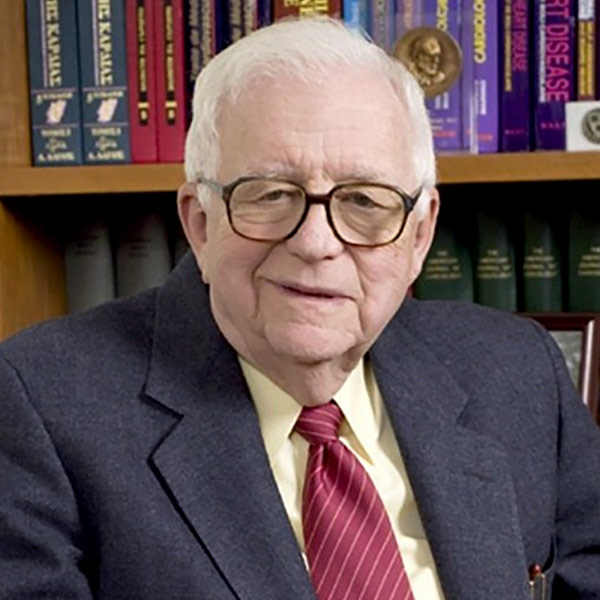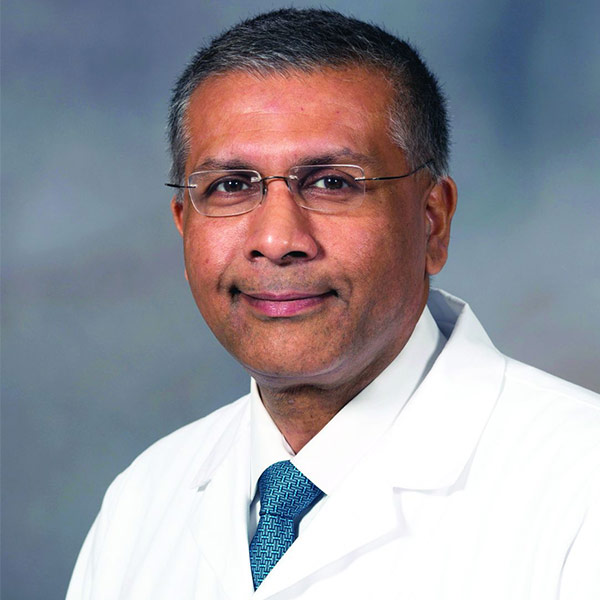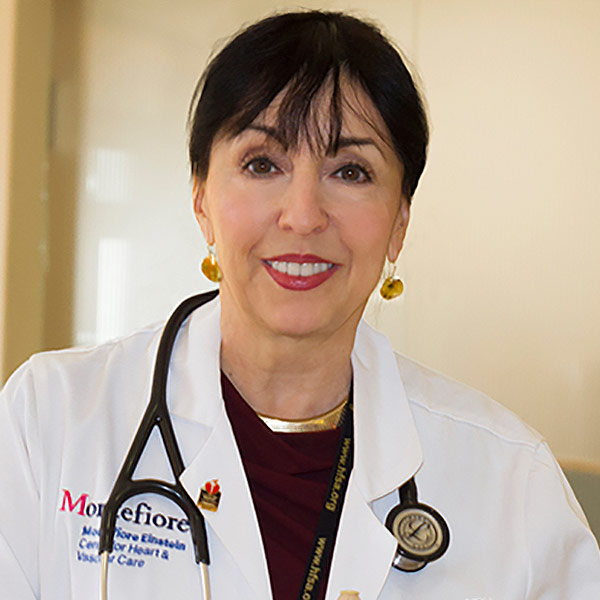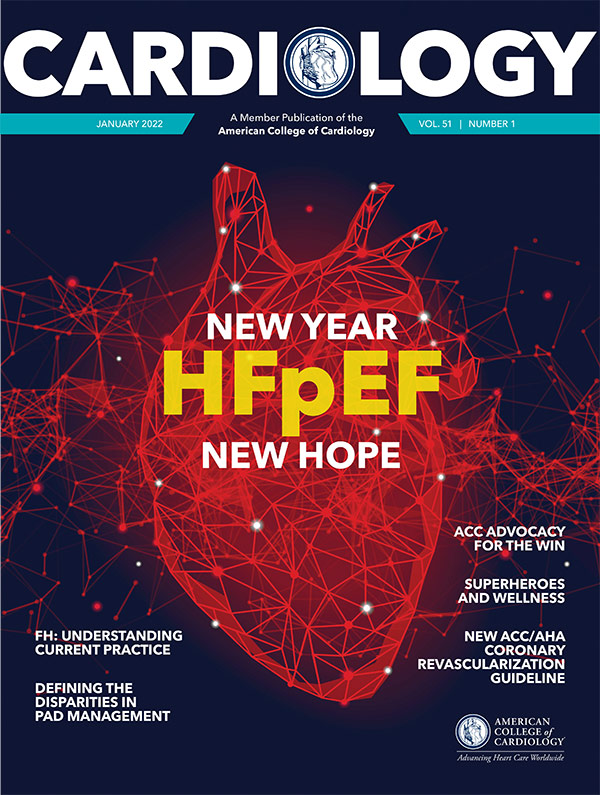Cover Story | HFpEF: New Year, New Hope

Heart failure with preserved ejection fraction (HFpEF) has been called the greatest unmet need in cardiovascular medicine.
About 6.2 million Americans and more than 23 million individuals worldwide have HF, with about half of them having HFpEF.1 Estimates suggest that by 2030 the prevalence of HF will increase by 46% and total medical costs in the U.S. alone may exceed $53 billion, with HFpEF patients, if anything, expected to outnumber heart failure with reduced ejection fraction (HFrEF).2
After years of failed trials and limited choices of a medical therapy that would directly treat these patients, cardiologists now have some options.
This month, Cardiology speaks to Eugene Braunwald, MD, MACC, widely considered the father of modern cardiology, and heart failure specialists Javed Butler, MD, MPH, FACC, and Ileana L. Piña, MD, MPH, FACC, to better understand the past, present and future of HFpEF and its treatment.



Some History
It's taken some time for the great physiologists of history to really understand the heart and how it fails. William Harvey's description of the circulation published in 1628 noted that "the intrinsic motion of the heart is not the diastole but the systole..."
This focus on systolic function and dysfunction, notes Braunwald, persisted with only a few exceptions through the 1960s, the period during which he and colleagues described two clinical techniques for assessing systolic function, namely the left ventricular (LV) systolic dp/dt and the LV ejection fraction (LVEF).3
"We took for granted that, of course, in between contractions there has to be relaxation, but we didn't think much about abnormalities in that," Braunwald tells Cardiology.
When the clinician scientists of the day did note diastolic dysfunction, it was in relation to specific etiologies like restrictive cardiomyopathy, such as amyloidosis.
"We were diagnosing these patients with normal EFs as having HF – because the syndrome of HF was recognized long before we knew how to measure EF – but it wasn't until the 1970s, when 2D echocardiography was developed, that people began to look at diastole carefully."
Eugene Braunwald, MD, MACC
In the late 1970s and early 1980s, researchers noted two physiologic abnormalities on echo that characterized diastole – one was prolonged isometric relaxation and the second was impaired compliance. "And when putting those two things together, we saw there were problems filling the ventricle," says Braunwald.
In 1983, one of the first papers that recognized many patients hospitalized for HF had EFs >50% noted that based on the symptoms and comorbidities, "the normal ejection fraction was unexpected clinically" in 90% of patients.4 In a second paper, in 1984, Dougherty, et al., reported that in 188 patients with HF, the EF was 45% or higher in 36%.5
"It was with the ADHERE registry, which looked at a broad sample of >100,000 patients hospitalized with acute decompensated HF, that we started to understand these patients with normal EFs were more common than we'd realized. And looked a bit different than we expected – they were mostly women and significantly older," says Piña, a heart failure transplant cardiologist and professor of medicine at Central Michigan University.
In ADHERE, evidence of mild or no impairment of systolic function was found in 46% of patients.6
And, Finally, Some Treatments
Until recently, treating HFpEF was often a frustrating experience. Beside the heterogeneity of the disease, which interferes with treatment effectiveness, every trial of every potential treatment – ACE inhibitors, ARBs, mineralocorticoid receptor antagonists (MRAs), digoxin, and sacubitril/valsartan – failed to demonstrate statistical superiority for their primary endpoints. And what has constituted a "success" in some subgroups has hardly been a resounding indication of benefit.
In the case of sacubitril/valsartan, subsequent analyses of the neutral but 'near-miss' PARAGON-HF trial showed enough treatment heterogeneity and potential benefit in some populations (those with lower EFs and women) for a U.S. Food and Drug Administration (FDA) indication for patients with HF and EFs "less than normal."
With the MRA spironolactone, the TOPCAT trial in patients with HFpEF was neutral, but a subsequent analysis showed that patients enrolled in North and South America benefited from the drug (vs. placebo), while those from Eastern Europe (Russia and the Republic of Georgia) did not.7
"They found that many of the patients enrolled in Eastern Europe probably didn't really have HFpEF and their compliance with the study medication was poor," notes Braunwald. "I think the drug works in HFpEF; it's inexpensive and generally well tolerated and should be used."
Ileana L. Piña, MD, MPH, FACC
Based on the North American data, the FDA convened a panel in December 2020 and the members voted 8 to 4 to expand the indication for spironolactone to HFpEF. "The HF world has, in general, accepted TOPCAT as a positive trial, and many practices are already using spironolactone," says Butler.
Butler is a heart failure specialist at the University of Mississippi in Jackson, MS, and was a principal investigator on the EMPEROR-Preserved trial.
"For years I have been using the combination of candesartan and spironolactone, coupled with a diuretic when it's needed, in my HFpEF patients in clinic and they do extremely well," says Piña.
And then came a clear win: the glucose-lowering SGLT2 inhibitor canagliflozin, which in early trials not only appeared to be cardiosafe but actually cardioprotective. (See SGLT2 inhibitor sidebar.)
A New Age of Treatment
EMPEROR-Preserved was a phase 3 randomized, double-blind trial that enrolled 5,988 adults with and without type 2 diabetes (T2D). Participants had HF (NYHA functional class II-IV) and preserved EFs (LVEF >40%).
Participants were randomized to once-daily empagliflozin 10 mg (n=2,997) or placebo (n=2,991), on top of treatment with guideline-directed HF therapy. Median follow-up time was 26.2 months. The composite primary endpoint was defined as time to first event of cardiovascular death or hospitalization for HF.
The results, presented at ESC 2021 and subsequently published in the New England Journal of Medicine, showed that over a median of 26.2 months, a primary outcome event occurred in 13.8% of the empagliflozin group and in 17.1% of the placebo group (hazard ratio, 0.79; p<0.001), a difference mainly driven by a 29% lower risk of HF hospitalization with empagliflozin.8
An LVEF cut-off of 40% was used, leading some to suggest that EMPEROR-Preserved should be viewed as a trial of patients with both HFpEF and HF with mildly reduced ejection fraction (HFmrEF), a category which all three of the clinicians interviewed for this story think tends to behave more like HFrEF than HFpEF.
"Early on we used to define normal EF as 55%, so I think a lot of what we're now calling HFmrEF and HFpEF is really just mild HFrEF," says Piña. "And you see in a lot of these trials that officially failed, and even with empagliflozin to some extent, the drugs lose some effect with the higher EFs."
In data just presented at AHA 2021, the EMPEROR-Preserved investigators showed that in the subgroup of patients with "true" HFpEF, with an LVEF ≥50%, there was still a significant 17% reduction in the composite endpoint of a first event of cardiovascular death or hospitalization for HF (p=0.026), driven by a 21% reduction in HF hospitalization (p=0.024).
Empagliflozin has not yet been approved for patients with preserved EFs, but on Sept. 9, 2021, on the heels of the ESC presentation of EMPEROR-Preserved, the FDA granted a Breakthrough Therapy designation for HFpEF for the drug.
On November 11, 2021, the FDA accepted a supplemental New Drug Application (sNDA) and granted Priority Review for empagliflozin 10 mg for adults with HF independent of LVEF, according to a Boehringer Ingelheim and Eli Lilly and Company press release.
"EMPEROR-Preserved is only one study in HFpEF, but it was a large global study and it came on top of all the other data that showed similar benefit for HF outcomes in various populations of patients," Butler notes.
The DELIVER (Dapagliflozin Evaluation to Improve the LIVEs of Patients With Preserved Ejection Fraction Heart Failure) trial in patients with HFmrEF and HFpEF, unless it's negative, will likely clinch the top spot for SGLT2 inhibitors across the HF spectrum, including in the troublesome HFpEF.
"Even without HFpEF, about which we're very optimistic, I believe the class of SGLT2 inhibitors are akin to statins in terms of their potential impact and will be considered one of the major pharmacological advances in cardiovascular medicine in the 21st century," says Braunwald.
It's a Part of Aging… But It's Not Just Aging
Prevention and Treatment Pearls
With new treatments coming, it's time to upgrade management of HFpEF and start doing the things already known to work, keeping in mind these new drugs have a powerful impact on prevention of HF in both patients with T2D as well as chronic kidney disease.
There are several ways by which HF can be prevented, or onset delayed, including living a healthy lifestyle and maintaining optimal body weight, not smoking and exercising, says Butler. But three medical interventions, specifically, have been shown to reduce the risk of new onset HF by 30% to 50%, and they remain underutilized, he adds, namely: blood pressure control, SGLT2 inhibitors in patients with T2D, and bariatric surgery in people for whom it is indicated.
Obesity and inactivity also have a huge impact on HFpEF patients, especially in women, says Piña. "Anything you can do to get your patients exercising more is important and it's safe to do. We saw the importance in the REHAB-HF trial, presented at ACC.21, of getting HF patients stronger and more stable in their balance."
"It is important to have a conversation with patients about the importance of staying active. Walking is an excellent activity and attainable by most," she adds. Even low level and recreational activity, like gardening, is beneficial.
The most recent numbers suggest that HFpEF will soon overtake HFrEF as the most common form of HF: the proportion of individuals with LVEF <40% is decreasing while the proportion with LVEF >50% is increasing. (The mid-range group is steady at about 15%.)9
Overall five-year survival appears similar in HFrEF and HFpEF, although in-hospital mortality is higher in HFrEF.10
The prevalence of HFpEF increases dramatically with age and is more common in women than men at any age. While the prevalence appears to be increasing, this is likely a function of the aging population and increased recognition of the diagnosis.9
"I think if we all start living until 110, everybody is likely to have diastolic dysfunction because the heart becomes more fibrous with age," says Braunwald.
It may seem intuitive that age leads to a "tired" heart that is unable to efficiently contract, but in fact, physiologically, the opposite is true, notes Butler.
"Heart requires energy, or ATP, for both contraction and relaxation. It requires ATP for actin-myosin interaction as well as calcium cycling. With energy deficiency, the relaxation process is impacted, not only contraction. That is why when an organism dies, the muscle goes into a contracted stage first, called rigor mortis."
It makes sense, he suggests, that the aging process leads to diastolic dysfunction preferentially. "It's not common that aging will lead to systolic dysfunction, but it's very common for it to lead to diastolic dysfunction."
As part of the preparation for new treatments, Butler would like to see a renewed emphasis on the diagnosis of HFpEF in patients who are symptomatic.
"The number one place HF gets diagnosed is in the emergency department. This is horrible, because it almost always means it was missed in the outpatient setting and the patient progressed to getting sick enough to show up there," says Butler.
"People go to their doctors with shortness of breath for months, and the doctors rule out appropriately chronic obstructive pulmonary disease, asthma, hypothyroidism, depression, anemia, even ischemia, but they don't think about HF. When they do not find an answer, they attribute it to obesity or aging and let the patient go. This is interesting considering that weeks or months before a person develops symptoms, they were of the same body habitus or age."
Now, with the ability to screen for elevated natriuretic peptides, missing HFpEF is really egregious. "It needs to come up in the differential diagnosis every time you see a patient with dyspnea, fatigue, any new symptoms that you might be tempted to attribute simply to aging. This is a message we really need to get out to primary care physicians, but also one we need cardiologists to hear because they are also not giving HFpEF its due, says Butler."
Of course, there are exceptions, namely some patients with HFpEF will have normal NT-proBNP. "But it takes care of the vast majority of patients who are picked up, and then we'll worry about that other minority in another way, for example, with invasive or provocative testing, he adds."
"Even cardiologists are far more likely to think about coronary artery disease than HFpEF, and as we go through this transition to having a really good medical therapy for these patients, I think we need to shift our focus," Butler says.
Who Will Prescribe SGLT2 Inhibitors?
While the multidomain benefits of SGLT2 inhibitors are attractive, they have spurred some debate regarding which subspecialty should take charge of implementing their widespread use.
Butler thinks these patients can mostly be managed in primary care, with cardiologists stepping in to rule out conditions such as amyloidosis, hypertrophic obstructive cardiomyopathy and ischemia.
"For most patients with just generic HFpEF, and certainly for those who also have T2D, I see them being managed in primary care using SGLT2 inhibitors, in part because they're already accustomed to using these drugs for T2D." Butler notes for cardiologists it may take some time to be comfortable with SGLT2 inhibitors because some patients with diabetes will require adjustment of other therapies, such as insulin, when initiating these agents. Obviously, this is not an issue in patients without T2D.
Javed Butler, MD, MPH, FACC
A poll conducted on ACC.org from late 2020 and published in the Journal of the American College of Cardiology showed that of nearly 500 cardiologists who responded, 65.8% believed cardiologists should take the lead in prescribing SGLT2 inhibitors for patients with HF, although 16.3% recommended a cardiologist prescribe only in those without T2D, leaving others to treat the patients with T2D who also require the drugs for cardiovascular reasons.11
A smaller proportion (17.9%) believed the primary care providers or noncardiac subspecialists (nephrology or endocrine) should be responsible for giving SGLT2 inhibitors.
For those with T2D, the most common barrier to prescribing was the potential for hypoglycemia or needing to adjust other diabetes medications (29.8%).
To assist cardiologists with incorporating SGLT2 inhibitors into the armamentarium for managing HF, the ACC updated its Expert Consensus Decision Pathway on novel therapies for cardiovascular risk reduction in patients with T2D. The clinical document provides detailed guidance on how to prescribe and monitor both SGLT2 inhibitors and GLP-1 receptor antagonists.12
A follow-up poll on this specific question hasn't been conducted. But the lead author, Richard Cheng, MD, MSc, FACC, says a new poll probably would show a shift in the paradigm toward a more cardiology-centric view on the use of SGLT2 inhibitors in HF. This is "due to a combination of recent data showing consistent benefit regardless of LVEF, increased familiarity with SGLT2 inhibitors, increased insurance approval rates for the HF indication, and better understanding of the safety profile."
This article was authored by Debra L. Beck, MSc.
SGLT2 Inhibitors: Regulatory Science Gone Wrong...or Right?
The SGLT2 inhibitor story is positively dripping with serendipity. And it goes beyond the simple fact that a drug designed to lower blood glucose levels is now being used to treat and prevent HF. It also makes for a fascinating case study in regulatory science.
In short, it all started with a diabetes drug seldom used anymore called rosiglitazone and a (likely) flawed meta-analysis.
In a 2007 paper published in the New England Journal of Medicine, a meta-analysis of 42 trials purported to show an increased risk associated with the thiazolidinedione rosiglitazone, then a best-selling drug.1 There were 86 myocardial infarctions in the rosiglitazone group and 72 in the comparator arm (including placebo, metformin, sulfonylurea or insulin), yielding an increased odds ratio (OR) of 1.43 and a p-value of 0.03 (95% confidence interval [CI], 1.03-1.98).2 On top of this, there was a borderline increase in cardiovascular death (OR, 1.64; 95% CI, 0.98-2.74; p=0.06).
The methodology used in the analysis was criticized and subsequent analyses found no increased cardiovascular risk with rosiglitazone.2-4 But the findings were also called a failure of the FDA approval and postapproval monitoring process and precipitated a cascade of events that ultimately led to a mandate from the FDA that all new glucose-lowering medications must have data that support their safety with respect to cardiovascular events before being approved for use in diabetes.
The new requirements, which translated to a prospective exclusion of excess cardiovascular risk of 30% or greater, were driven by a general concern about cardiac safety in antihyperglycemic medications; the specific safety concern over rosiglitazone and the possibility it had perhaps slipped through the regulatory process; and the high prevalence of cardiovascular disease in diabetes (accounting for approximately 70% of deaths).5
Subsequent large cardiovascular outcome trials (CVOTs) of GLP-1 receptor agonists and DPP-4 inhibitors failed to provide evidence of an unexpected cardiovascular risk.6 In the case of the SGLT2 inhibitor empagliflozin, earlier trials, confirmed by the CVOT, revealed such an unexpected cardioprotective benefit that the results of EMPA-REG OUTCOME, when first presented at the 2015 European Association for the Study of Diabetes meeting, were met with a standing ovation.
In short, in a population of just over 7,000 patients with T2D and established cardiovascular disease at high risk for cardiovascular events, over a median of 3.1 years, empagliflozin reduced the risk of the primary composite outcome of cardiovascular death, nonfatal myocardial infarction or nonfatal stroke by 14% (p=0.04), with the difference driven primarily by a 38% relative risk reduction in cardiovascular death (p<0.001).7 Empagliflozin also reduced HF hospitalization by 35% and all-cause death by 32%.
Importantly, additional analyses of EMPA-REG showed the drug improved HF outcomes both in patients with and without baseline HF.8
SGLT2 inhibitors are now foundational in the treatment of HFrEF, regardless of the presence or absence of T2D, and are also shown to slow the development of kidney disease.
Specific to HFpEF, there was a suggestion from some trials that this subgroup of patients might also benefit from SGLT2 inhibitor treatment, leading to EMPEROR-Preserved.
"It's an amazing story of serendipity," says Butler. Before the FDA mandate, he notes, a diabetes drug would be approved after being tested in a just few hundred patients followed for several months, measuring glycemic control. The mandated CVOTs followed thousands of patients for a much longer time frame. "I don't think we'd have realized the value of SGLT2 inhibitors in HF without this requirement."
His role in the story shows the extent to which this new class of agents required a paradigm shift. "They saw such a major signal of benefit in the early trials, they didn't want to just ignore it, but they also couldn't figure out what it might mean," relates Butler.
"I was approached at the AHA meeting to talk to an endocrinologist involved in developing empagliflozin. He did not understand HF and I'd never even heard of SGLT2 inhibitors and did not really understand the nuances of diabetes. We spoke for more than an hour and started to understand the potential that was there," remembers Butler.
Ironically, in 2020, the FDA reversed course and no longer requires extensive cardiovascular testing for new glucose-lowering agents in the absence of specific safety signals. Now, a new medication need only show acceptable safety from phase 3 trials in sufficient numbers of patients with established cardiovascular disease, chronic kidney disease and age over 65 years.
References
- Nissen SE, Wolski K. Effect of rosiglitazone on the risk of myocardial infarction and death from cardiovascular causes. N Engl J Med 2007;356:2457-71.
- Turner RJ. FDA's New guidance for industry addressing evaluation of the safety of new drugs for improving glycemic control: A case study in regulatory science. Ther Innov Regul Sci 2021;55:1-5.
- Diamond GA, Bax L, Kaul S. Uncertain effects of rosiglitazone on the risk for myocardial infarction and cardiovascular death. Ann Intern Med 2007;147:578-81.
- Richter B, Bandeira-Echtler E, Bergerhoff K, et al. Rosiglitazone for type 2 diabetes mellitus. Cochrane Database Syst Rev 2007;(3):CD006063.
- Smith RJ, Goldfine AB, Hiatt WR. Evaluating the cardiovascular safety of new medications for type 2 diabetes: Time to reassess? Diabetes Care 2016;39:738-42.
- Ferro EG, Michos ED, Bhatt DL, et al. New Decade, New FDA guidance for diabetes drug development: Lessons learned and future directions. J Am Coll Cardiol 2020;76:2522-6.
- Zinman B, Wanner C, Lachin JM, et al. Empagliflozin, CARDIOVASCULAR OUTCOMES, AND MORTALITY IN TYPE 2 DIabetes. N Engl J Med 2015;373:2117-28.
- Fitchett D, Zinman B, Wanner C, et al. Heart failure outcomes with empagliflozin in patients with type 2 diabetes at high cardiovascular risk: results of the EMPA-REG OUTCOME trial. Eur Heart J 2016;37:1526-34.
Resources Supporting Your Practice
Learn more about these emerging therapies and the relationship between diabetes and cardiovascular disease with ACC's free Online Courses. The Cardiovascular Risk in Diabetes: Applying Emerging Science to Practice program offers curated resources from podcasts and patient case quizzes to expert analyses and more. From the Clinical Spotlight series, join experts for the Cardiovascular Risk in Diabetes: Applying Emerging Science to Practice course and the What's New in HF Pharmacotherapies: The What, How, and Wow course to navigate the new management landscape of emerging therapies and their practical application. Click here to access these courses and more.
Click here for ACC's 2020 Expert Consensus Decision Pathway on Novel Therapies for Cardiovascular Risk Reduction in Patients With Type 2 Diabetes.
Click here to download the accompanying Clinician Tool.
Put all the guidelines from ACC in your pocket today with the Guideline Clinical App. Visit ACC.org/MobileResources.
References
- Virani SS, Alonso A, Aparicio HJ, et al. Heart disease and stroke statistics-2021 update: A report from the American Heart Association. Circulation 2021;143:e254-e743.
- Ziaeian B, Fonarow GC. Epidemiology and aetiology of heart failure. Nat Rev Cardiol 2016;13:368-78.
- Braunwald E. Heart failure with preserved ejection fraction: a stepchild no more! Eur Heart J 2021;42:3900-1.
- Echeverria HH, Bilsker MS, Myerburg RJ, Kessler KM. Congestive heart failure: echocardiographic insights. Am J Med 1983;75:750-5.
- Dougherty AH, Naccarelli GV, Gray EL, et al. Congestive heart failure with normal systolic function. Am J Cardiol 1984;54:778-82.
- Adams KF, Fonarow GC, Emerman CL, et al. Characteristics and outcomes of patients hospitalized for heart failure in the United States: rationale, design, and preliminary observations from the first 100,000 cases in the Acute Decompensated Heart Failure National Registry (ADHERE). Am Heart J 2005;149:209-16.
- Pitt B, Pfeffer MA, Assmann SF, et al. Spironolactone for heart failure with preserved ejection fraction. N Engl J Med 2014;370:1383-92.
- Anker SD, Butler J, Filippatos G, et al. Empagliflozin in heart failure with a preserved ejection fraction. N Engl J Med 2021;385:1451-61.
- Lam CS, Shah SJ, Solomon SD. Heart Failure with Preserved and Mildly Reduced Ejection Fraction. Chapter 51. In: Braunwald's Heart Disease. A Textbook of Cardiovascular Medicine. 12th ed. Elsevier; 2022.
- Felker GM, Teerlink JR. Diagnosis and Management of Acute Heart Failure. In: Braunwald's Heart Disease. A Textbook of Cardiovascular Medicine. 12th ed. Elsevier; 2022.
- Cheng RK, Mooney DM, Chien CV, et al. SGLT2 inhibitors: Who should prescribe them for patients with heart failure? J Am Coll Cardiol 2021;77:1375-77.
- Das SR, Everett BM, Birtcher KK, et al. 2020 expert consensus decision pathway on novel therapies for cardiovascular risk reduction in patients with type 2 diabetes: A report of the American College of Cardiology Solution Set Oversight Committee. J Am Coll Cardiol 2020;76:1117-45.
Clinical Topics: Cardiovascular Care Team, Diabetes and Cardiometabolic Disease, Dyslipidemia, Geriatric Cardiology, Heart Failure and Cardiomyopathies, Noninvasive Imaging, Prevention, Atherosclerotic Disease (CAD/PAD), Nonstatins, Novel Agents, Statins, Acute Heart Failure, Echocardiography/Ultrasound, Exercise
Keywords: ACC Publications, Cardiology Magazine, Actins, Adenosine Triphosphate, Aged, Aging, Amyloidosis, Anemia, Angiotensin Receptor Antagonists, Angiotensin-Converting Enzyme Inhibitors, Arm, Asthma, Bariatric Surgery, Blood Glucose, Blood Pressure, Body Weight, Calcium, Canagliflozin, Cardiologists, Cardiology, Cardiomyopathy, Hypertrophic, Cardiomyopathy, Restrictive, Cardiovascular Diseases, Confidence Intervals, Consensus, Coronary Artery Disease, Depression, Diabetes Mellitus, Type 2, Diagnosis, Differential, Diastole, Digoxin, Dipeptidyl-Peptidase IV Inhibitors, Diuretics, Double-Blind Method, Dyspnea, Echocardiography, Emergency Service, Hospital, Endocrinologists, Europe, Eastern, Fatigue, Follow-Up Studies, Gardening, Georgia (Republic), Glucagon-Like Peptide-1 Receptor, Glucose, Glycemic Control, Healthy Lifestyle, Heart Disease Risk Factors, Heart Failure, Heel, Hospital Mortality, Hospitalization, Hydroxymethylglutaryl-CoA Reductase Inhibitors, Hypoglycemia, Hypothyroidism, Insulins, Insurance, Ischemia, Metformin, Michigan, Mineralocorticoid Receptor Antagonists, Muscles, Myocardial Infarction, Myosins, Natriuretic Peptides, Near Miss, Healthcare, Nephrology, Obesity, Odds Ratio, Outpatients, Persons With Hearing Impairments, Pharmaceutical Preparations, Physicians, Primary Care, Prevalence, Primary Health Care, Prospective Studies, Pulmonary Disease, Chronic Obstructive, Registries, Renal Insufficiency, Chronic, Rigor Mortis, Risk Factors, Rosiglitazone, Russia, Sodium-Glucose Transporter 2 Inhibitors, South America, Spironolactone, Stroke, Stroke Volume, Systole, Treatment Outcome, United States Food and Drug Administration, Universities, Valsartan, Visually Impaired Persons, Walking
< Back to Listings

